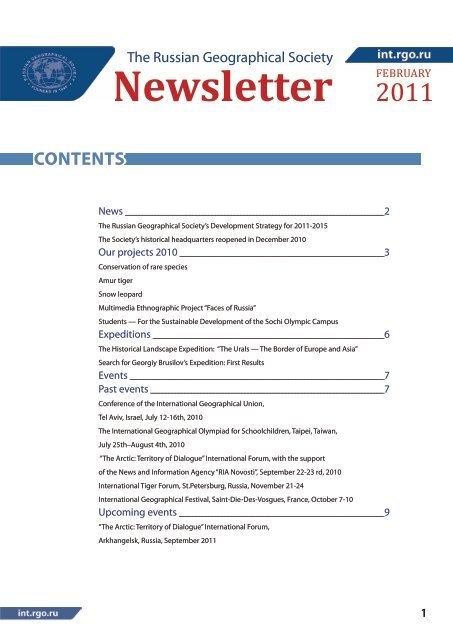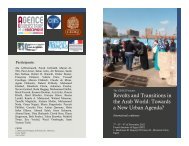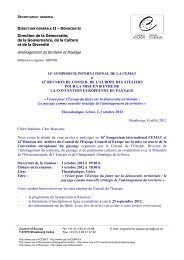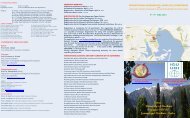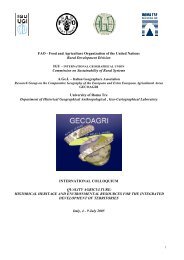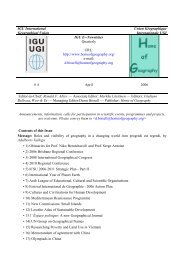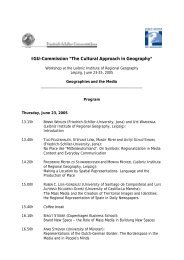Russian Geographical Society, Newsletter 2011 - Home of Geography
Russian Geographical Society, Newsletter 2011 - Home of Geography
Russian Geographical Society, Newsletter 2011 - Home of Geography
Create successful ePaper yourself
Turn your PDF publications into a flip-book with our unique Google optimized e-Paper software.
The <strong>Russian</strong> <strong>Geographical</strong> <strong>Society</strong><br />
<strong>Newsletter</strong><br />
FEBRUARY<br />
<strong>2011</strong><br />
Contents News<br />
News 2<br />
The <strong>Russian</strong> <strong>Geographical</strong> <strong>Society</strong>’s Development Strategy for <strong>2011</strong>-2015<br />
The <strong>Society</strong>’s historical headquarters reopened in December 2010<br />
Our projects 2010 3<br />
Conservation <strong>of</strong> rare species<br />
Amur tiger<br />
Snow leopard<br />
Multimedia Ethnographic Project “Faces <strong>of</strong> Russia”<br />
Students — For the Sustainable Development <strong>of</strong> the Sochi Olympic Campus<br />
Expeditions 6<br />
The Historical Landscape Expedition: “The Urals — The Border <strong>of</strong> Europe and Asia”<br />
Search for Georgiy Brusilov’s Expedition: First Results<br />
Events 7<br />
Past events 7<br />
Conference <strong>of</strong> the International <strong>Geographical</strong> Union,<br />
Tel Aviv, Israel, July 12-16th, 2010<br />
The International <strong>Geographical</strong> Olympiad for Schoolchildren, Taipei, Taiwan,<br />
July 25th–August 4th, 2010<br />
“The Arctic: Territory <strong>of</strong> Dialogue” International Forum, with the support<br />
<strong>of</strong> the News and Information Agency “RIA Novosti”, September 22-23 rd, 2010<br />
International Tiger Forum, St.Petersburg, Russia, November 21-24<br />
International <strong>Geographical</strong> Festival, Saint-Die-Des-Vosgues, France, October 7-10<br />
Upcoming events 9<br />
“The Arctic: Territory <strong>of</strong> Dialogue” International Forum,<br />
Arkhangelsk, Russia, September <strong>2011</strong><br />
1
News<br />
The <strong>Russian</strong> <strong>Geographical</strong> <strong>Society</strong>’s Development Strategy for <strong>2011</strong>-2015<br />
The meeting <strong>of</strong> the <strong>Russian</strong> <strong>Geographical</strong> <strong>Society</strong>’s Academic<br />
Council was held on the 11th <strong>of</strong> December. It was chaired by<br />
the <strong>Society</strong>’s President Sergei Shoigu.<br />
President Sergei Shoigu presented for review and approval <strong>of</strong><br />
the Academic Council the <strong>Society</strong>’s Development Strategy for<br />
<strong>2011</strong>-2015. The document outlines the <strong>Society</strong>’s objectives for<br />
the next five years, as well as the steps for their fulfillment.<br />
Initiatives described in the Strategy build on the <strong>Russian</strong> <strong>Geographical</strong><br />
<strong>Society</strong>’s long history and experience.<br />
The basic concept <strong>of</strong> the new Strategy is <strong>Russian</strong> national geography<br />
– comprehensive exploration <strong>of</strong> the country in all its<br />
diversity, to contribute to a fuller implementation <strong>of</strong> Russia’s<br />
and its people’s potential.<br />
Full text <strong>of</strong> the Strategy is available at the <strong>Society</strong>’s website:<br />
http://int.rgo.ru/<br />
The <strong>Society</strong>’s historical headquarters reopened in December 2010<br />
In 2010, the <strong>Russian</strong> <strong>Geographical</strong> <strong>Society</strong> celebrated its 165th<br />
anniversary. The <strong>Society</strong>’s historical headquarters, located in<br />
Grivtsova Pereulok, building 10 in Saint-Petersburg, is a witness<br />
<strong>of</strong> the <strong>Society</strong>’s history and a symbol <strong>of</strong> its revival. All these<br />
165 years the building has served the <strong>Society</strong>’s needs, not for a<br />
day closing its doors.<br />
At the turn <strong>of</strong> the 21st century, the building was in need <strong>of</strong> substantial<br />
renovation. Renovation works lasted throughout 2010<br />
and have been finished just recently. The building and its interiors,<br />
which represent the <strong>Society</strong>’s scientific, cultural and symbolic<br />
heritage, have been restored according to their original<br />
design.<br />
On 11 December 2010, the newly restored headquarters <strong>of</strong> the<br />
<strong>Russian</strong> <strong>Geographical</strong> <strong>Society</strong> gathered within its walls a large<br />
number <strong>of</strong> scholars, as well as descendants and successors <strong>of</strong><br />
the great <strong>Russian</strong> travellers. They came to take part in the opening<br />
ceremony <strong>of</strong> the 14th Congress <strong>of</strong> the <strong>Russian</strong> <strong>Geographical</strong><br />
<strong>Society</strong>.<br />
The historical building, constructed over a century ago, has<br />
been reconstructed in record time, and it is highly symbolic<br />
that the <strong>Society</strong> commences its rebirth within the walls <strong>of</strong> its<br />
original headquarters.<br />
2
Our projects<br />
The projects <strong>of</strong> the <strong>Russian</strong> <strong>Geographical</strong> <strong>Society</strong> serve the purpose<br />
<strong>of</strong> attracting the public’s attention to important geographical and<br />
ecological issues. Our goal is to provide an authoritative venue for<br />
discussing these issues, to exchange expert opinions, publish research<br />
findings and take a lead role in supporting related initiatives.<br />
The Board <strong>of</strong> Trustees <strong>of</strong> the <strong>Russian</strong> <strong>Geographical</strong> <strong>Society</strong> provides<br />
grant funding to projects <strong>of</strong> national importance after project<br />
proposals have been thoroughly evaluated by our team <strong>of</strong> experts.<br />
The list <strong>of</strong> upcoming projects is to be announced after<br />
the Board <strong>of</strong> Trustees meeting in March.<br />
Here are some <strong>of</strong> our projects that took <strong>of</strong>f in 2010.<br />
Conservation <strong>of</strong> rare species<br />
The first in the series <strong>of</strong> programs was dedicated to the lord <strong>of</strong> the Ussuri taiga — the<br />
Siberian tiger. Currently, there are programs protecting the polar bear, the Far-Eastern<br />
leopard, the snow leopard and the white whale. Since August 2010, the programs<br />
will be implemented under the auspices <strong>of</strong> the <strong>Russian</strong> <strong>Geographical</strong> <strong>Society</strong>.<br />
<strong>Russian</strong> scientists and the government have been giving special attention to these five<br />
species for quite a while already. All <strong>of</strong> them are at the top <strong>of</strong> the food chain in their<br />
area and serve as important indicators <strong>of</strong> their habitats’ ecosystems condition.<br />
All five species, except for the white whale, are included in the Red Data Book <strong>of</strong> the<br />
<strong>Russian</strong> Federation and the Red List <strong>of</strong> Threatened Species <strong>of</strong> the International Union<br />
for Conservation <strong>of</strong> Nature (IUCN).<br />
Amur tiger<br />
The Amur (or Siberian) tiger is the largest<br />
and the most beautiful <strong>of</strong> all tiger subspecies.<br />
It’s native to the <strong>Russian</strong> Far East,<br />
namely the Primorye and Khabarovsk regions.<br />
It is enlisted in the Red Book <strong>of</strong> the<br />
<strong>Russian</strong> Federation and the Red List <strong>of</strong><br />
Threatened Species <strong>of</strong> the International<br />
Union for Nature Conservation (IUCN).<br />
There are around 450 Amur tigers, inhabiting<br />
the taiga and the deciduous forests<br />
<strong>of</strong> the <strong>Russian</strong> Far East. The Amur<br />
tiger is the true czar <strong>of</strong> the taiga. Remarkably<br />
powerful and enduring, the animal<br />
has adapted to living in the harsh conditions<br />
<strong>of</strong> the Far-Eastern winters.<br />
Watching the mighty feline roaming<br />
confidently around the taiga forests covered<br />
with deep snow, its black-striped<br />
orange fur contrasting with the white<br />
background, fills you with awe and deep<br />
respect. Tiger is worshiped by many<br />
peoples <strong>of</strong> the <strong>Russian</strong> Far East. Instead<br />
<strong>of</strong> calling the predator directly by its<br />
3
name taskhu (tiger), they <strong>of</strong>ten admiringly<br />
call it amba (big one).<br />
Despite this pr<strong>of</strong>ound veneration, it is<br />
people and their activities that have put<br />
the survival <strong>of</strong> the Amur tiger under<br />
threat. The causes for declining population<br />
<strong>of</strong> the big cat are attributed to<br />
poaching (not only <strong>of</strong> the tiger itself, but<br />
also their prey species), massive logging,<br />
construction <strong>of</strong> industrial factories, and<br />
extension <strong>of</strong> road network.<br />
The Amur tiger was the first endangered<br />
species to be taken special care <strong>of</strong> by specialists<br />
from the A.I. Severtsov Institute<br />
<strong>of</strong> Evolution and Ecology (<strong>Russian</strong> Academy<br />
<strong>of</strong> Sciences) and other research organizations.<br />
The program embraces non-invasive<br />
DNA and hormone analysis, research <strong>of</strong><br />
the species numbers and distribution in<br />
Russia, their seasonal migration patterns,<br />
genetic status and health, conservation<br />
issues, as well as other important aspects<br />
<strong>of</strong> their life in the wild. The program also<br />
includes educational and outreach projects<br />
for the local people to raise their environmental<br />
awareness.<br />
Snow leopard<br />
The irbis, or the snow leopard (Uncia uncia,<br />
Shreber 1775), has a unique place among<br />
the felid species. The irbis is a large cat with<br />
smoky-greyish-brownish fur with a pattern<br />
<strong>of</strong> large spots on their body. The long, thick<br />
fur protects it from the cold. The unusually<br />
long tail can sometimes be over a meter in<br />
length and reach three quarters <strong>of</strong> the body<br />
length. The irbis itself is about 120-125 cm<br />
long, with a weight <strong>of</strong> up to 45 kg.<br />
The name ‘irbis’ has a long history in<br />
the <strong>Russian</strong> language. As far back as<br />
the 17th century, <strong>Russian</strong> fur traders<br />
have borrowed this name from the local<br />
Asian hunters, many <strong>of</strong> whom spoke<br />
Turkic languages. They pronounced the<br />
name ‘irbiz’, meaning ‘snow cat’. The<br />
‘snow’ part came from the fact that the<br />
animal lives in the mountains up to 4500<br />
meters above sea level, among the snow<br />
fields and glaciers at the feet <strong>of</strong> mountain<br />
peaks, where strong cold winds blow<br />
constantly. In current <strong>Russian</strong> usage,<br />
the term ‘snezhnyi bars’ (a translation<br />
<strong>of</strong> the English ‘Snow leopard’) is quite<br />
common, although technically incorrect<br />
from the point <strong>of</strong> view <strong>of</strong> <strong>Russian</strong> zoological<br />
terminology.<br />
The range <strong>of</strong> the snow leopard extends<br />
over the high-altitude regions <strong>of</strong> Asia<br />
and includes the territories <strong>of</strong> 13 countries:<br />
Afghanistan, Burma, Bhutan, India,<br />
Kazakhstan, Kyrgyzstan, China,<br />
Mongolia, Nepal, Pakistan, Russia, Tajikistan,<br />
and Uzbekistan.<br />
Within the whole <strong>of</strong> its range, the snow<br />
leopard has not been comprehensively<br />
studied. Russia is the northernmost<br />
reach <strong>of</strong> its range, which mainly extends<br />
over the Altai-Sayan mountainous area<br />
and constitutes about 3-4% <strong>of</strong> the current<br />
range. The peripheral nature <strong>of</strong><br />
the irbis population in Russia, increasingly<br />
active invasion into its habitat, the<br />
fragmentation <strong>of</strong> the range and the decrease<br />
in snow leopard numbers mean<br />
that there is an urgent need to develop<br />
measures for its conservation not only<br />
within specially protected area, but also<br />
in ecosystems shared with people.<br />
The Snow Leopard Conservation Programme,<br />
just like the Amur Tiger Conservation<br />
Programme embraces noninvasive<br />
DNA and hormone analysis;<br />
research <strong>of</strong> the species numbers and distribution<br />
in Russia; seasonal migration<br />
patterns <strong>of</strong> the big cats and their prey;<br />
genetic status and health; conservation<br />
issues, and other important aspects <strong>of</strong><br />
their life in the wild.<br />
Scientists are planning to conduct their<br />
research using camera traps, which will<br />
enable them to identify individual leopards<br />
and assess the animals remaining in<br />
the wild. During the summer expedition<br />
<strong>of</strong> 2010, scientists succeeded in taking<br />
the first good quality picture <strong>of</strong> a snow<br />
leopard. Camera traps will also allow<br />
specialists to assess the number <strong>of</strong> leopard<br />
prey species and learn about their<br />
migration patterns.<br />
Another way <strong>of</strong> studying the snow leopard<br />
will be with the use <strong>of</strong> satellite collars.<br />
These high-tech devices will enable<br />
scientists to track the animals’ movements<br />
and will also shed light on social<br />
relations and habits <strong>of</strong> these highly endangered<br />
felines.<br />
“The project’s ultimate goal is not only to<br />
obtain extensive scientific data about the<br />
species, which is a worthy aim as such,<br />
but also to contribute to conservation <strong>of</strong><br />
this rare species”, says Vyacheslav Rozhnov,<br />
project leader and deputy head <strong>of</strong><br />
the A.I. Severtsov Institute <strong>of</strong> Ecology<br />
and Evolution within the <strong>Russian</strong> Academy<br />
<strong>of</strong> Sciences.<br />
Apart from scientific research, the program<br />
also envisages educational projects<br />
for the local population, university and<br />
school students, which aim at raising<br />
their environmental awareness and increasing<br />
their knowledge <strong>of</strong> local nature.<br />
To achieve this, the project team actively<br />
collaborates with the local mass media.<br />
4
Multimedia Ethnographic Project<br />
“Faces <strong>of</strong> Russia”<br />
Students — For the Sustainable<br />
Development <strong>of</strong> the Sochi Olympic<br />
Campus<br />
With the aid <strong>of</strong> contemporary multimedia<br />
and communication technologies this project<br />
is to create a resource about the Russia’s<br />
experience <strong>of</strong> cherishing the national cultures<br />
<strong>of</strong> peoples, living in Russia.<br />
Objectives <strong>of</strong> the project are to:<br />
• Organize expeditions to make videos and collect ethnographic<br />
data.<br />
• Organize exhibits and other events, publish books, and develop<br />
study materials for <strong>Russian</strong> schools.<br />
• Publish an almanac about peoples <strong>of</strong> <strong>Russian</strong> Federation.<br />
• Design and publish a brochure “Peoples <strong>of</strong> Russia.”<br />
• Update the website www.rusnations.ru. This website contains<br />
detailed information with images and audio resources about<br />
every people and ethnic group <strong>of</strong> the <strong>Russian</strong> Federation. This<br />
website also <strong>of</strong>fers access to archives and three-dimensional<br />
photographs <strong>of</strong> the displays from the Saint-Petersburg’s Kunstkamera,<br />
significant scientific publications on ethnography<br />
<strong>of</strong> the peoples <strong>of</strong> Russia, and news related to their culture and<br />
traditions.<br />
The project seeks to involve talented young<br />
individuals in the sustainable social development<br />
movement through research and<br />
educational projects including preparation<br />
activities for the Olympic Games in Sochi.<br />
Objectives <strong>of</strong> the project are to:<br />
• Develop an innovative student project aimed at enhancing<br />
sustainable development <strong>of</strong> the region.<br />
• Prepare research findings for publication.<br />
• Develop popular scientific reference publications about the<br />
region.<br />
• Collect information about natural and archeological landmarks,<br />
and new objects <strong>of</strong> the region’s infrastructure.<br />
• Assess the region’s natural potential and its cultural-historical<br />
heritage for the purpose <strong>of</strong> developing the tourist industry.<br />
• Assess opportunities for initiating innovative activities aimed<br />
at bringing out the region’s potential.<br />
5
Expeditions Events<br />
The Historical Landscape Expedition:<br />
“The Urals — The Border <strong>of</strong> Europe and Asia”<br />
The Historical Landscape Expedition<br />
“The Urals – The Border <strong>of</strong> Europe and<br />
Asia” is an extensive one-year long project<br />
<strong>of</strong> the <strong>Russian</strong> <strong>Geographical</strong> <strong>Society</strong>.<br />
In the course <strong>of</strong> the project the researchers<br />
will tread along the suggested border<br />
between Europe and Asia from the<br />
Kara Sea (the Yugorsky Strait) and up<br />
to the north-east shore <strong>of</strong> the Caspian<br />
Sea (Komsomolets Bay in Kazakhstan’s<br />
Mangystau Province).<br />
It is a widely accepted axiom that the Ural<br />
Mountains divide Europe and Asia. In the<br />
middle <strong>of</strong> the 18th century by the initiative<br />
<strong>of</strong> Vasily Tatishchev the center part<br />
<strong>of</strong> the Ural Mountains <strong>of</strong>ficially became<br />
the border <strong>of</strong> Europe and Asia. Earlier<br />
in the history, the border was “mapped”<br />
along the rivers Tanais and Don, according<br />
to Herodotus; along Volga and Kama<br />
rivers, according to Arabic sources; and<br />
even the Ob river, according to Delille.<br />
Even towards the end <strong>of</strong> the 19th century,<br />
the Orenburg General-Governor Nokolai<br />
Kryzhanovsky in his speech at the<br />
opening ceremony <strong>of</strong> a local branch <strong>of</strong><br />
Emperor’s <strong>Russian</strong> <strong>Geographical</strong> <strong>Society</strong>,<br />
said that “Geographers have accepted the<br />
ridge <strong>of</strong> the Ural Mountains and River<br />
Ural to be a border between Europe and<br />
Asia. Others ignore the opinions <strong>of</strong> the<br />
geographers <strong>of</strong> Russia and Europe and<br />
state that Asia starts right on the eastern<br />
bank <strong>of</strong> Volga River. Therefore, the cities<br />
<strong>of</strong> Orenburg, Ufa and others should be<br />
considered part <strong>of</strong> Asia.”<br />
So, where exactly does Asia meet with Europe<br />
In the course <strong>of</strong> three centuries the<br />
Ural Mountains have been identified by<br />
world science and culture as the border<br />
<strong>of</strong> two parts <strong>of</strong> the world. Nevertheless, a<br />
more precise border between Europe and<br />
Asia still needs to be determined. Specialists<br />
seems to be unanimous regarding<br />
the location <strong>of</strong> some sections <strong>of</strong> the<br />
border, such as the stretch from the Kara<br />
Sea coastline along Pai Khoy and further<br />
along the Ural-Tau mountain ridge up to<br />
the head <strong>of</strong> the Belaya River, (flowing into<br />
the Volga River), the Ural River (flowing<br />
into the Caspian Sea) and the Uya (flowing<br />
into the Arctic Ocean). The southern<br />
part <strong>of</strong> the border between Europe and<br />
Asia, suggested by Vasily Nikitich Tatishchev<br />
is questionable. First, the main<br />
ridge in this area continues into at least<br />
three branches. Second, the Ural Mountains<br />
lose their role as the main water dividing<br />
ridge, which moves to the south <strong>of</strong><br />
the Ilmen Mountains. Third, south <strong>of</strong> 51°<br />
520’ north latitude the mountains “disappear”,<br />
which allows the Ural River in<br />
the areas <strong>of</strong> the Orsk Gates and the “Guberlinskoe<br />
ushchel’e” to cut through the<br />
whatever is left from the Ural Mountains<br />
and flow further to the south-east part <strong>of</strong><br />
the Eastern-European plateau, the near<br />
Caspian lowland and ultimately into Europe.<br />
In the middle <strong>of</strong> the 19th century,<br />
Nikolai Severtsev wrote: “From the point<br />
<strong>of</strong> view <strong>of</strong> natural sciences, the two banks<br />
<strong>of</strong> the Ural River are identical. It [the<br />
Ural River] does not divide anything, it<br />
simply flows across the Kirghiz steppe.”<br />
The question arises – where is the border<br />
between Asia and Europe located south<br />
<strong>of</strong> Zlatoust<br />
The team <strong>of</strong> twelve participants <strong>of</strong> the<br />
expedition from Orenburg and Kazakhstan<br />
hope to be able to answer this question.<br />
The first leg <strong>of</strong> the itinerary goes<br />
from Orenburg to Uralsk, then further<br />
to Atyrau, Mangyshlak, the Caspian Sea,<br />
Severny Ustyurt, Mugodzhary, and back<br />
to Orenburg. The expedition will follow<br />
the footsteps <strong>of</strong> the scientists and topographers<br />
<strong>of</strong> the 19th century, some <strong>of</strong><br />
which were Grigory S. Karelin, Vladimir<br />
D. Volkhovsky, Eduard F. Eversmann,<br />
Fedor F. Von Berg among others.<br />
Anticipated results <strong>of</strong> the expedition<br />
By the end <strong>of</strong> the project we expect not<br />
only to show a complete and contemporary<br />
course <strong>of</strong> the border between Europe<br />
and Asia from the Kara Sea to the Caspian<br />
Sea, but also to ensure that contemporary<br />
textbooks reflect those changes. We<br />
will also develop a travel guide giving a<br />
comprehensive overview <strong>of</strong> travel along<br />
the border. We will place markers on the<br />
southern and northern ends <strong>of</strong> the Urals<br />
Mountains, make recommendations for<br />
establishing new reserves, national parks<br />
and tourist routes along the border between<br />
Europe and Asia in the territory <strong>of</strong><br />
the <strong>Russian</strong> Federation and Kazakhstan.<br />
We hope that our efforts will also create a<br />
positive social environment for the local<br />
peoples (Nentsi, Khanty, Mansi, Bashkirs,<br />
and Kazakhs) and attract investment<br />
to the region.<br />
The most important task in finding the<br />
geographic border is not only to identify<br />
“the line” that divides Europe and<br />
Asia, but particularly to find the line that<br />
unites the two continents.<br />
6
Search for Georgiy Brusilov’s Expedition: First Results<br />
<strong>Russian</strong> explorers, who set <strong>of</strong>f to Franz Josef Land archipelago<br />
in search <strong>of</strong> Georgiy Brusilov’s Arctic expedition, which disappeared<br />
almost 100 years ago, have found human remains and a<br />
number <strong>of</strong> artifacts possibly belonging to the lost 1912 expedition,<br />
according to one <strong>of</strong> the participants.<br />
“We’ve managed to find remains <strong>of</strong> a human body, fragments<br />
<strong>of</strong> clothes and equipment. We believe it was a member <strong>of</strong> Albanov’s<br />
group lost around here 96 years ago. A pocket watch,<br />
a spoon with engraved “P.S.” initials, homemade bottle-glass<br />
spectacles, fragments <strong>of</strong> snow shoes, three rifle cartridges<br />
marked 1910-1911, a mug, a knife and bucket remnants were<br />
found near the remains”, said he.<br />
“All these items have been mentioned in Albanov’s journals.<br />
The composition <strong>of</strong> the find allows to suggest that the remains<br />
belong to Pavel Smirennikov, one <strong>of</strong> the four missing persons.<br />
Currently we’re collecting more material and preparing to<br />
move the remains to the “big land” for further examination”,<br />
said the explorer.<br />
In 1912 Georgiy Brusilov’s expedition set <strong>of</strong>f from St. Petersburg<br />
on-board the schooner St. Anna. Its tragic story became<br />
widely known after the publication <strong>of</strong> Veniamin Kaverin’s famous<br />
book “The Two Captains”.<br />
The fate <strong>of</strong> the ship and some <strong>of</strong> the crew which stayed onboard<br />
still remains a mystery. Out <strong>of</strong> the 11 people who left the<br />
schooner and made for the “big land”, only two survived: navigator<br />
Valerian Albanov and sailor Alexander Konrad. We know<br />
what happened to them from Albanov’s journal published in<br />
1917.<br />
The destiny <strong>of</strong> the four members <strong>of</strong> Albanov’s group, who got<br />
lost somewhere between Cape Nil and Cape Grant in George<br />
Land island <strong>of</strong> Franz Josef Land archipelago, also remained unknown<br />
during all that time.<br />
The expedition <strong>of</strong> the <strong>Russian</strong> scientists was intended to find<br />
traces <strong>of</strong> the lost group in George Land Island.<br />
Events<br />
The <strong>Russian</strong> <strong>Geographical</strong> <strong>Society</strong> takes a vivid interest in geographical<br />
sciences and makes considerable efforts towards dissemination <strong>of</strong><br />
geographical knowledge. Therefore the <strong>Society</strong> both acts as organizer<br />
<strong>of</strong>, and actively participates in local and international geographical<br />
congresses, conferences, forums, workshops, exhibitions, festivals<br />
and other events aimed at sharing knowledge and experience, finding<br />
solutions to the world’s pressing issues and raising awareness about<br />
geography at the global level.<br />
Past events Events<br />
Conference <strong>of</strong> the International <strong>Geographical</strong> Union, Tel Aviv, Israel,<br />
July 12-16th, 2010<br />
The conference <strong>of</strong> the International <strong>Geographical</strong> Union was held<br />
in Tel Aviv under the title “Bridging Diversity in a Globalizing<br />
World”. The <strong>Russian</strong> <strong>Geographical</strong> <strong>Society</strong> delegation took part in<br />
this conference. Members <strong>of</strong> the delegation participated in scientific<br />
panels. Also, the <strong>Russian</strong> <strong>Geographical</strong> <strong>Society</strong> held an exhibition<br />
<strong>of</strong> materials from the <strong>Society</strong>’s archives, and presented a number<br />
<strong>of</strong> photographic and video materials, and museum artifacts.<br />
Photos made by <strong>Society</strong>’s photographer at this conference are<br />
available at our website: http://int.rgo.ru/<br />
7
The International <strong>Geographical</strong> Olympiad for Schoolchildren, Taipei,<br />
Taiwan, July 25th–August 4th, 2010<br />
The <strong>Russian</strong> <strong>Geographical</strong> <strong>Society</strong> prepared a team for the International<br />
<strong>Geographical</strong> Olympiad for Schoolchildren. The<br />
<strong>Russian</strong> team was made up <strong>of</strong> four high school students who<br />
showed the best results at the All-<strong>Russian</strong> <strong>Geography</strong> Olympiad.<br />
For 2 weeks, the young geographers had intensive training in<br />
a special camp to prepare for the Olympiad. This year, thanks<br />
to the grant allocated by the <strong>Russian</strong> <strong>Geographical</strong> <strong>Society</strong>, the<br />
range <strong>of</strong> activities in the training camp was extended: more attention<br />
was given to field work, English and psychology.<br />
Ksenia Sokolova from Russia, who came 4th out <strong>of</strong> 106 contenders,<br />
is one <strong>of</strong> the youngest students to get gold in this competition.<br />
In 2015 the International <strong>Geographical</strong> Olympiad should take<br />
place in Russia.<br />
“The Arctic: Territory <strong>of</strong> Dialogue” International<br />
Forum, with the support <strong>of</strong> the News and Information<br />
Agency “RIA Novosti”, September 22-23 rd, 2010<br />
“The Arctic: Territory <strong>of</strong> Dialogue” international<br />
forum is one <strong>of</strong> the largest international<br />
projects <strong>of</strong> the <strong>Russian</strong> <strong>Geographical</strong><br />
<strong>Society</strong> in 2010.<br />
Main issues discussed at the Forum:<br />
• Current problems <strong>of</strong> the Arctic: national<br />
interests and international dialogue<br />
• The environment <strong>of</strong> the Arctic: climate<br />
change and the consequences <strong>of</strong> human<br />
activity<br />
• The Arctic natural resources: the source<br />
<strong>of</strong> the region’s prosperity and a chance<br />
for cooperation<br />
• Sustainable development <strong>of</strong> the Arctic<br />
region: problems and perspectives<br />
International <strong>Geographical</strong> Festival, Saint-Die-des-Vosgues, France,<br />
October 7-10.<br />
In 2010 the International <strong>Geographical</strong> Festival was dedicated<br />
to the topic “Rational forest management: from natural<br />
resources to forest industry”.<br />
Each year the organizational committee selects the country —<br />
the guest <strong>of</strong> honor. In 2010 Russia was such a guest, represented<br />
by the <strong>Russian</strong> <strong>Geographical</strong> <strong>Society</strong>.<br />
The <strong>Society</strong> presented a number <strong>of</strong> scientific papers and video<br />
materials, opened up the exhibit dedicated to the history <strong>of</strong> the<br />
<strong>Society</strong> and the exhibit “Forests <strong>of</strong> Russia”.<br />
8
International Tiger Forum, St.Petersburg, Russia, November 21-24.<br />
From 21 to 24 November 2010, Saint-Petersburg<br />
hosted the International Tiger<br />
Forum, dedicated to protection and conservation<br />
<strong>of</strong> the global tiger population.<br />
Organised by the <strong>Russian</strong> Federation<br />
Ministry <strong>of</strong> Natural Resources, with<br />
participation <strong>of</strong> the <strong>Russian</strong> <strong>Geographical</strong><br />
<strong>Society</strong>, the Forum was set to unite<br />
government leaders <strong>of</strong> 13 tiger range<br />
countries, including Russia, Bangladesh,<br />
Bhutan, Vietnam, India, Indonesia,<br />
Cambodia, China, Laos, Malaysia,<br />
Myanmar, Nepal and Thailand. Their<br />
main objective has been “working out a<br />
plan <strong>of</strong> tiger recovery and conservation<br />
in its traditional habitat, as well as tilting<br />
the international public opinion in<br />
favour <strong>of</strong> tiger protection”.<br />
The very fact that an animal species was<br />
discussed at such a high level, demonstrated<br />
the importance the global community<br />
assigns to wildlife and environment<br />
protection.<br />
The Forum served as a venue for top-level<br />
policy debates, and provided an opportunity<br />
for experts to share their knowledge<br />
and practical experience.<br />
Upcoming events Events<br />
“The Arctic: Territory <strong>of</strong> Dialogue” International Forum, Arkhangelsk,<br />
Russia, September <strong>2011</strong><br />
One <strong>of</strong> the large international projects <strong>of</strong> the <strong>Russian</strong> <strong>Geographical</strong><br />
<strong>Society</strong> in 2010 was the conference “The Arctic: Territory<br />
<strong>of</strong> Dialogue”.<br />
The second Forum will take place in Arkhangelsk, the birthplace<br />
<strong>of</strong> Mikhail Lomonosov to mark the scientist’s 300th birth<br />
anniversary in September <strong>2011</strong>.<br />
The forum will focus on shipping in the Arctic region, international<br />
cooperation in the development <strong>of</strong> circumpolar areas<br />
and the development <strong>of</strong> the Northern Sea Route.<br />
Federal Number/ Fax:<br />
8-800-700-1845<br />
International Number/Fax:<br />
+7-495-933-5055<br />
Contacts<br />
Working hours:<br />
Monday-Friday: Weekends:<br />
7 a.m. – 9 p.m. 8 a.m. – 8 p.m.<br />
(Moscow time) (Moscow time)<br />
E-mail: rgo@rgo.ru<br />
Executive Directorate:<br />
Monday-Friday:<br />
9 a.m. – 6 p.m.<br />
(Moscow time)<br />
www.rgo.ru<br />
9


